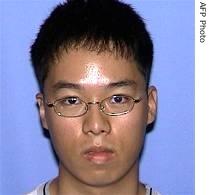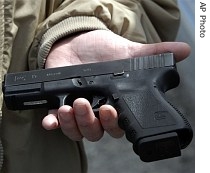2007年VOA标准英语-Experts See Disturbing but Familiar Pattern in(在线收听)
Washington
18 April 2007
Authorities in Virginia are slowly gathering and revealing information about Cho Seung Hui, the university student who police say was responsible for the worst mass-shooting spree in U.S. history. VOA National correspondent Jim Malone has more from Washington.
 |
| Cho Seoung-hui |
Lucinda Roy, a creative writing professor at Virginia Tech, took note of Cho's writing and volunteered to work with him privately. Roy found him distant and lonely and tried to convince Cho to get professional counseling, without success.
"I was very concerned because it seemed to me that he was writing from a place of anger and I needed to make sure that I met with him and talked with him and tried to find out what was going on," she said.
In addition, police found a rambling note in Cho's dorm room expressing anger toward women and rich students.
[NBC News in New York says it has received a package apparently sent by the young Virginia Tech student who killed 32 people before killing himself.
NBC News officials Wednesday said the network had turned the package containing pictures, writings and a video over to the FBI.]
Police also said two women students had accused Cho of stalking them in 2005. Cho's parents were worried their son was suicidal at the time and he was taken to a mental health facility for assessment and later released.
As more details come out about Cho's troubled life, criminal experts say they see a disturbing but familiar pattern of behavior.
 |
| Roanoke Firearms owner John Markell holds a Glock 9mm pistol similar to the one sold in his gun shop 36 days ago to Virginia Tech shooting suspect Cho Seung-Hui |
In retrospect, Levin says there were plenty of warning signs in Cho's behavior, some of which were noticed by students and professors.
Levin also says it is a pattern of behavior well known to those who study incidents of mass violence.
"This young man looks very much like the other mass killers that I have studied," he added. "He sought revenge against other students on campus. He was depressed for a long period of time. He blamed everybody but himself for his miseries, and he was a loner. He was emotionally isolated so that when he got into trouble, he really had no place to turn."
Another expert, Princeton University Sociology Professor Katherine Newman, has a different take on the common description of mass killers as loners. Newman has written a book on the roots of school shootings in the U.S. and was interviewed on The Early Show on CBS TV.
"It is typically what the media says about school shooters, but in the research I have done, it is rarely actually the case," she explained. "They are usually failed joiners, people who continuously try to join social groups and are rebuffed and their daily experience is one of rejection and friction."
Experts agree that preventing similar incidents in the future is a daunting task.
Jack Levin says early intervention for those who appear troubled, if possible, can make a difference.
"We have got to get to individuals based on warning signs like depression and social isolation, frustration and anger, long before they decide they want to go out and kill 32 people," he said. "Then we can help them and we might even prevent a murderer or two."
Levin and other social and criminal experts are already drawing parallels between Cho and the two disaffected students responsible for the 1999 massacre at Columbine High School in Colorado. A total of 12 students and a teacher died in that incident before the two shooters killed themselves.